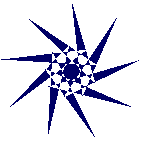7
C
H
A
P
T
E
R
All About
Groups
Group theory might be described as the study of symmetry, since collecting symmetries is the way in which groups are formed (such as finding all of the possible ways that a regular polygon can be repositioned by means of rotating, flipping, etc., and yet, still fill the space that it originally occupied). Group theory is a useful tool in areas of study such as physics and engineering, and groups turn out to have a lot to do with puzzles like Rubik’s Cube. (As a matter of fact, the Rubik’s cube configuration space is a group.) To see group theory in action, let’s consider the symmetires of a square . . .
A group consists of three “entities,” the first of which is a nonempty set.
The second entitiy is a binary operation, which is a function (a rule or formula) that assigns to a given pair of elements some third element, with all three elements coming from the same set.
And the third and final entity that is necessary in order to have a group has already been mentioned: a pair of elements.
As previously mentioned, collecting symmetries is the way in which groups are formed. But, at this point, that statement is probably too abstract and rather meaningless. To help us grasp the concept of collecting symmetries, let’s use a concrete object: a transparent square.with the corners on one side color-coded as follows:


R90→
H→
--------------------
The result is that the square ends up in the same position it would have been in had we flipped it 180° about the “other” diagonal (running from the upper right-hand corner to the lower left-hand corner), for which the code is D′ . Consequently, what we have is R90*H = D′ (Please note that the * symbol stands for our binary operation.)
So, what we now have is a set with the following elements:
S = {R0, R90, R180, R270, H, V, D, D′}
However, before we can label this set as a group there are four conditions that it must meet.
- It must be closed. That means that every result obtained by applying the binary operation to each pair of elements from the set is a member of the set as well. (So far, so good!)
- It must also have identity. In other words, there must be an element e, called the identity, such that a*e = e*a = a.


 (Since H*R0 = R0*H = H we’re still okay.)
(Since H*R0 = R0*H = H we’re still okay.)
- It must have inverses. For each element a there is an element b (called the inverse of a) such that ab = ba = e.

 (Given that DD′ = D′D = R180 of we’re still in the clear.) No we are not. That doesn't make sense!
(Given that DD′ = D′D = R180 of we’re still in the clear.) No we are not. That doesn't make sense!
- And finally, the set must have a associativity . . . that is,
 (ab)c = a(bc) for all a, b, c in the set.
(ab)c = a(bc) for all a, b, c in the set.
Since grouping the manipulations will not affect the outcome, as long as the order remains the same, all four conditions have been met. Hence, the symmetries of a square form a group.
DEFINITION FOR A GROUP
A group is a nonempty set, together with a binary operation (usually called multiplication) that assigns to each ordered pair of elements (a,b) some element from the same set, denoted by ab. (The set is a group under the given binary operation if and only if the properties of closure, associativity, identity, and inverses are satisfied.)
Note that, were we to rotate the square, there is a maximum of four (4) different positions in which it would occupy the space it occupies now, and a total of two (2) possible orientations – face up and face down.
This means that there are a total of eight (8) different positions (4 × 2 = 8) in which the square will fit in the space it originally occupied.
Now, to form a group we need to create a nonempty set that has elements which can be “paired-up” in order to get yet another element of the set.
In our set, those elements consist of the ways in which we can manipulate the transparent square so that it occupies its original position.
Let’s assign the following codes to the following manipulations:
CODE
- R0
- R90
- R180
- R270
- H
- V
- D
- D′
Any of the eight positions previously mentioned can be obtained by performing one of the above manipulations. Moreover, we can perform a sequence of two manipulations and get the same result as a single manipulation all by itself. Consequently, we are now able to form a group.
Suppose that the square flipped 180° about its horizontal axis and then rotated 90° counter clockwise as follows . . .
 =
= rotate the square 0° (no change in position)
rotate the square 0° (no change in position)
 =
= rotate the square 90° (counter clockwise)
rotate the square 90° (counter clockwise)
 =
= rotate the square 180° (counter clockwise)
rotate the square 180° (counter clockwise)
 =
= rotate the square 270° (counter clockwise)
rotate the square 270° (counter clockwise)
 =
= flip the square 180° about the horizontal axis
flip the square 180° about the horizontal axis
 =
= flip the square 180° about the vertical axis
flip the square 180° about the vertical axis
 =
= flip the square 180° about the main diagonal
flip the square 180° about the main diagonal
 =
= flip the square 180° about the other diagonal
flip the square 180° about the other diagonal
EXAMPLE OF GROUPS:
- integers under addition
- the rational numbers under addition
- the real numbers under addition
- the complex numbers under addition
- the non-zero rationals under multiplication
- reals under multiplication
- complex numbers under multiplication
- non-singular matrices under multiplication
- invertible functions under composition.
- An abelian group: the nonzero rational numbers



 under multiplication
under multiplication